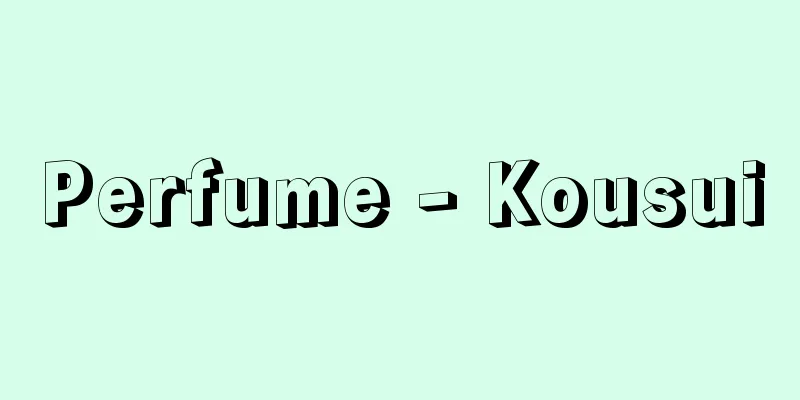Perfume - Kousui

|
A type of aromatic product (called a fragrance product) in which a blend of fragrance ingredients is mixed with ethanol (ethyl alcohol) to a concentration of 20-25%. It is applied to the body, clothing, and personal items for the purpose of refinement, fashion, and enjoyment. In English, it is called perfume, and in French, parfum or extrait. In a broad sense, however, it is a general term for products with lower fragrance content, such as parfum de toilette and eau de parfum (10-15% content) or eau de toilette (5-10%), eau de cologne (3-5%), and splash cologne (1-2%). Strictly speaking, Eau de Cologne is not a classification based solely on the amount of fragrance contained, but is the name of a long-established aromatic perfume that was born in Italy at the beginning of the 18th century, grew in Germany, and flourished in France. Its predecessor was a medicinal water called "Aqua Mirabilis," a miraculous water that appeared in Italy, and this was brought to the Prussian capital of Cologne (French for Collonne) at the end of the 17th century or the beginning of the 18th century, where it gained popularity under the name "Cologne Water." During the Seven Years' War that began in 1756, French soldiers who occupied Cologne were completely captivated by this famously fragrant water, and brought it back to their home country, where it took on the French name "Eau de Collonne" (Eau de Cologne is the English pronunciation). Originally, eau de cologne was made by mixing citrus oil with rosemary (Japanese name: Mannenrou), lavender, and mint, and diluting it to about 2% with 60% hydroalcohol, and its selling point was the cool, refreshing feeling it gave when applied, and there are still many fans of traditional eau de cologne in Europe and the United States. Recently, perfume variations and scented lotions made especially for men are also called eau de cologne. In the broad sense, fragrance products include not only perfumes, but also fancy powders, bath perfumes, perfumed soaps, space perfumes (room colognes, car colognes), interior fragrances, incense (solid perfume, perfumed incense sticks), sachets (scented bags), etc. [Tatsuya Umeda] historyThe history of "fragrant dressing" using perfumes dates back as far as 3000 BC in ancient civilizations such as Egypt and Greece. In ancient Egypt, from 2000 BC to 1500 BC, "perfumed oils" and "ointments" were made by mixing aromatic resins such as myrrh and frankincense with olive oil or animal fat, and were initially used only in religious ceremonies as sacred items. Around 1000 BC, however, they began to be used by noble women to give fragrance and moisture to the skin. By the 1st century AD, the use of these perfumed oils and ointments had spread from Egypt and Greece to the upper classes of ancient Rome, and the amount and variety of perfumes used increased. It is said that Cleopatra used the highest quality perfumed oil, worth 200,000 yen in today's value, just to rub it on both hands. Eventually, people began to think of powdering spices and mixing them with wine, and by the 5th century, the practice of scenting the body, clothes, rooms, etc. gradually became common. This is the distant ancestor of perfume. On the other hand, when we look at perfume as "scented water," there is another root to it. It is "rose water," which was brought to Greece from the East around the 8th century BC. This is a fragrant perfume made by squeezing rose flowers or steeping them in water, but later, perfumes using flowers other than roses appeared, and from the 5th to 4th centuries BC onwards, fragrant perfumes were consumed in large quantities by members of upper class for hand washing and spraying in the room, and also as medicine (painkillers and sedatives). Eventually, this trend led to fragrant perfumes using the distillation method invented in Arabia at the end of the 10th century (the origin of steam distillation, a common method of extracting plant essential oils today), and further to "alcoholic lotions" that were created in the 12th century. The most famous of these is "Hungarian water," which was taught to Queen Elisabeth of Hungary by a learned hermit in 1370. This lotion was made by distilling alcohol over rosemary flowers, and there is a legend that a queen in her 80s at the time rejuvenated herself by using it, and was then proposed to by the young king of neighboring Poland. It reigned supreme as the most aromatic perfume until the advent of eau de cologne in the 18th century. As for perfume oils, which are the mainstream of perfume, the variety has increased since the 5th century, when many aromatic plants were discovered in Western countries, and in the Middle Ages, animal-based fragrances such as musk, civet, and ambergris were introduced from China and Arabia. As late as the 16th century, powdered "fragrance powder" began to be produced in France and Italy to replace perfume oils. In the mid-16th century, Frangipani, a Roman aristocrat, created the famous "Frangipani powder," which became the basis of perfumery techniques that incorporate animal fragrances, an essential ingredient in perfume blends. His grandson then succeeded in dissolving the fragrance components by heating this with alcohol. This was the birth of "alcoholic perfume." In the 18th century, the craze for fragrances was growing throughout Europe, and it became possible to cultivate aromatic plants, mainly flowers, and to extract aromatic components (called plant essential oils) by distilling or extracting them, making it easier to mix fragrances. Furthermore, it was the appearance of synthetic fragrances beginning in the 1830s that paved the way for the transition from the relatively monotonous classical perfumes based on floral essential oils to the complex and delicate modern perfumes. Especially since around 1920, there has been remarkable progress in analytical and synthesis technology, and many fragrance compounds that do not exist in nature, as well as aromatic compounds found in plants and animals, have been synthesized one after another, and today the number has reached more than 3,000. This has given perfumers the freedom to create scents with individuality and according to their imagination, resulting in the creation of many masterpieces and classics. In Japan, perfume used to mean "scented water offered to Buddha." In the Edo period, the first "water scented with flowers," rose water, was brought to Nagasaki by the Dutch. Hiraga Gennai, in his book Butsuruihinshitsu (1763), gives a detailed description of how to use and preserve rose water under the name "Bara no Tsuyu." Following this trend, Yoshiya Ruemon of Yoshicho, Nihonbashi (near present-day Nihonbashi Kofunecho, Chuo Ward) produced the first domestically produced "Sakura Water Perfume" in 1872 (Meiji 5), and by around 1880, several stores were selling various kinds of fragrant perfumes made from flowers. The name "Eau de Cologne" also appeared in the early Meiji period. In Kanagaki Robun's novel of manners, "Agura Nabe" (1871-72), there is a passage that says, "They use a perfume called Eau de Cologne..." Also, in 1877, the Yomiuri Shimbun carried an advertisement for the "Chrysanthemum Perfume Eau de Cologne," which is thought to be the beginning of eau de cologne in Japan. Eventually, simple floral perfumes began to be imported, mainly from France, and at the time they were called Eagle Brand Perfume, Pig Brand Perfume, Waterfall Perfume, Hina Perfume, etc., based on the patterns on the bottle labels, and were popular among people with a taste for novelties during the Meiji Restoration era. The first full-fledged perfume was Roger Galley's Heliotrope, which was released in the mid-Meiji period, and the name of this perfume is even mentioned in Natsume Soseki's Sanshiro. In the case of Japanese people, due to differences in perception and customs regarding fashionable fragrances, consumption of fragrance cosmetics such as perfume is surprisingly low, with sales in 1999 (Heisei 11) amounting to just under 10 billion yen, a mere 1.5% of the total shipment value of cosmetics of 1.48 trillion yen (import value was 22.5 billion yen). [Tatsuya Umeda] How to make itJust as music and painting are art of sound and color, perfume can be said to be a "work of art of scent." Perfumers combine dozens or even hundreds of different fragrance ingredients from a selection of 1,000 or 2,000 to create a single fragrance based on a theme or image. Fragrance materials can be broadly classified into natural fragrances and artificial fragrances, the former being further divided into animal-derived fragrances and plant-derived fragrances, and the latter into isolated fragrances and synthetic fragrances. There are four types of animal-derived fragrances: musk from musk deer, ambergris from sperm whales, civet from civet cats, and castoreum from beavers. However, the first two are rarely used today due to restrictions imposed by the Convention on International Trade in Endangered Species of Wild Fauna and Flora (CITES), and have been replaced by synthetic fragrances. Botanical fragrances are made by extracting aromatic components (plant essential oils) contained in various parts of plants through physical processes such as steam distillation, solvent extraction, and pressing. Isolated fragrances are aromatic compounds extracted from plant essential oils by precision distillation or simple chemical processing. Synthetic fragrances include semi-synthetic fragrances made from isolated fragrances, and pure synthetic fragrances made through complex reaction processes from chemical raw materials obtained from petroleum, coal, oils and fats. Perfumers remember the scents and uses of the main ingredients. They create perfumes in roughly the following steps: (1) First, they create the base note, that is, the scent that forms the framework of the theme they want to express. For a single floral scent, they create the scent of a single flower; for a floral bouquet, they create the scent of a combination of several types of flowers; for a fantasy scent, they build up the scent of the landscape, person, event, or image that is the subject of the scent. (2) Next, they flesh out the framework, that is, they add charm, breadth, and foundation to the base note. The fragrances used for this are called modifiers. (3) To this, they add the top note, which corresponds to the overture or introduction in music, and then they ensure a smooth transition to the base note. (4) Finally, they use animal fragrances, aromatic resins, or crystalline or viscous fragrances to adjust the volatility and give the overall scent roundness, depth, and persistence. The fragrances that perform this function are called fixatives. In perfume production, the perfumer first creates a perfume base by mixing the ingredients evenly in a mixing tin based on a recipe that lists the names and quantities of the ingredients used in the work. This base is then mixed with high-quality deodorized ethanol, placed in a storage tank that is sealed, and aged in a cool, dark place for one to three months. After precision filtration, the product is bottled and packaged. Recently, attempts have been made to use ultra-short waves or ultrasound for short-term aging. [Tatsuya Umeda] kindsThere are two types of perfumes: "floral type," which has a base scent of flowers, and "fancy type," which expresses the image of the perfumer's imagination through the scent of flowers, plants, natural phenomena, scenery, people, music, paintings, etc. Floral perfumes can also be divided into three types: (1) "single floral," which imitates the scent of natural flowers; (2) "floral bouquet," which has a feminine and elegant scent reminiscent of a bouquet of flowers or a flower garden; and (3) "modern floral," which is more complex and incorporates elegance and chic, making it romantic and sweet. On the other hand, fantasy perfumes include "green notes" that express fresh nature such as grasslands, forests, orchards, and animals, "chypre notes" that are unique and sophisticated and follow the tradition of "chypre," a perfume that became famous for its fresh moss scent based on the paste incense made in Cyprus in the 14th century, and "oriental notes" with an oriental mood. In addition, there are unique men's notes such as "citrus notes" that mainly feature citrus fruits, "fougere notes" that make use of the scent of lavender and moss, and "leather notes" that combine the scent of spices and wood with leather. [Tatsuya Umeda] Fragrance characteristicsThe perfume that a person wears all the time asserts its presence even if the person is not present, and this is a major characteristic of perfume. It is said that a good perfume must have a consistent scent, even if it changes subtly over time from the moment the scent starts to evaporate until the moment it finishes. Therefore, fragrances are classified into three categories: (1) overt, (2) neutral, and (3) lingering, and a fragrance is not sufficient if any of these three elements are missing. (1) Overt is the scent that is first felt when the bottle cap is opened, and is highly volatile and therefore does not last long (about 20 minutes). Neutral is the scent that most accurately conveys the characteristics of the perfume, and usually lasts for about three hours. This is where the image of the fragrance that the perfumer wants to create is most strongly expressed. Then comes lingering. It is a faint scent that has a long lasting effect, mixes with body odor, and depending on the perfume, it can linger for two to three days if left unattended. [Fumisako Yokota] Use of perfumeHow to Choose(1) Perfume is diluted with alcohol, so if you put your nose to the mouth of the bottle to smell it, the pungent smell of alcohol will numb your sense of smell and you will not be able to sense it properly. Always put a drop on the back of your hand, blow on it to remove any residual odor, and then examine it. If the perfume remains oily after dropping it on the back of your hand, it is a perfume that will last longer, but since the life of a perfume is its scent, long-lasting perfumes are not necessarily the best. (2) Don't worry about the color of the perfume. Dark-colored perfumes often contain natural plant resins or animal fragrances. Therefore, dark-colored perfumes tend to have strong, long-lasting scents. (3) Since a fragrance blends with the wearer's body odor to create a new fragrance for that person, it is a good idea to choose a perfume of the same type, taking into consideration the relationship with the scent of the cosmetics you use. (4) The only way to choose a perfume that suits you is to be patient with it. It is important to become familiar with as many types of perfume as possible. One way to do this is to start with cologne to get used to the scent. [Fumisako Yokota] How to apply(1) The best way to use perfume is to spray it directly onto the skin from a certain distance. (2) The scent only lasts for a certain amount of time, so don't forget to add more if necessary. To do this, you should always have perfume on you. (3) People with sensitive skin or hypersensitivity should soak cotton wool in it and place it in their bra or spray it on their underwear. (4) Do not apply it directly to clothing. The more expensive the perfume, the more likely it is to stain. (5) Each perfume has its own unique, perfect fragrance, so you should never mix them together. (6) Eau de Toilette and eau de cologne, which are less concentrated than perfume, can be used in large quantities, and are more effective when used after a bath or shower when your body temperature is higher (except for those with idiosyncratic constitutions). [Fumisako Yokota] How to enjoy(1) Remove the lid from the empty bottle and place it in a dresser drawer for clothes or underwear. (2) Add a little official alcohol to the bottle that still has a small amount of perfume remaining, shake well, and then soak a wet towel for wiping your hands. (3) You can also spray perfume on the cover of a desk lamp or on curtains to add a nice fragrance to the room. (4) It is also good to use perfume sometimes to leave a faint scent on the palms of your hands after shaking hands. [Fumisako Yokota] Storage method(1) Perfume bottles should be stored in a cool, dark place, as exposing them to light can cause them to become cloudy and lose their smell. (2) If the temperature is too low, the crystalline fragrance can separate and settle from the alcohol. (3) Perfume tends to evaporate if left for a long time, so keep the stopper tightly closed. As the amount of perfume in a bottle decreases, it can oxidize due to the air inside, so if possible, transfer it to a smaller bottle or use it as soon as possible. [Fumisako Yokota] "The Natural History of Perfumery" by C.J.S. Thompson, translated by Komazaki Yuji (1973, Tokyo Shobosha)" ▽ "Perfume" by Katada Michihisa (Hoikusha, Color Books) ▽ "The Cultural History of Fashion" by Haruyama Yukio, 3 volumes (1980, Heibonsha) ▽ "An Invitation to Fragrances" by Umeda Tatsuya (1979, Kenseisha) [References] | | | | | | |Source: Shogakukan Encyclopedia Nipponica About Encyclopedia Nipponica Information | Legend |
|
調合された香料をエタノール(エチルアルコール)で20~25%の濃度にした芳香製品(フレグランス製品という)の一つ。たしなみ、おしゃれ、楽しみといった目的で、身体、衣服、身の回りの物などにつける。英語ではパフュームperfume、フランス語ではパルファンparfumまたはエクストレーextraitという。ただし広い意味では、香料含有量のより低いパルファン・ド・トアレおよびオー・ド・パルファン(含有量10~15%)またはオー・ド・トアレ(5~10%)、オーデコロン(3~5%)、スプラッシュ・コロン(1~2%)などを総称する。 このうちオーデコロンは、厳密にいうと香料の含有量のみの区分ではなく、18世紀の初めにイタリアで生まれ、ドイツで育ち、フランスで花開いた由緒ある芳香水の名称である。その前身はイタリアに現れた「不思議の水――アクア・ミラビリス」という薬用水で、これが17世紀末か18世紀の初めにプロイセンの都ケルン(フランス語名コローニュ)に持ち込まれ「ケルンの水」の名で人気を博した。1756年に始まった七年戦争のおり、ケルンを占領したフランスの将兵がこの名だたる香りの水にすっかり魅了され、これを本国に持ち帰り、その名もフランス風に「オー・ド・コローニュ」とよばれるようになった(オーデコロンはその英語読み)。本来のオーデコロンは、柑橘(かんきつ)油を主体にローズマリー(和名マンネンロウ)、ラベンダー、ハッカ(ミント)などを混ぜ合わせ、それを60%の含水アルコールで2%ほどに薄めたもので、つけたときの清涼・爽快(そうかい)感を売り物としており、欧米ではいまでも昔ながらのオーデコロンの愛用者は多い。最近では香水をアレンジしたものや、男性用にとくにつくられた香りの化粧水もオーデコロンとよんでいる。 ちなみに広義のフレグランス製品には、香水類のほか、ファンシーパウダー、バスパフューム、パフュームソープ、スペースパフューム(ルームコロン、カーコロン)、インテリアフレグランス、インセンス(練り香水、香水線香)、サシェ(匂い袋)などがある。 [梅田達也] 歴史香料による「香りの装い」の歴史は、遠く紀元前3000年のエジプト、ギリシアなど古代文明の国々に始まる。前2000年から前1500年ごろの古代エジプトでは、没薬(もつやく)、乳香(にゅうこう)などの芳香樹脂を、オリーブ油または動物脂と混ぜ合わせた「香油」と「香膏(こうこう)」がつくられ、神聖なものとして最初は宗教的儀式にのみ使われていた。それが前1000年のころからは、高貴な女性たちの間で、肌に香りと潤いを与えるために用いられるようになった。その後紀元1世紀ごろまでの間に、この香油、香膏の使用は、エジプト、ギリシアから古代ローマの上流階級の人々へと広がり、使用量も香料の種類も増えていった。かのクレオパトラは、両手にぬるだけでいまの価値にして20万円もする最高級の香油を使ったといわれる。そのうち、香料を粉にしてぶどう酒と混ぜることも考えられ、5世紀ごろまでに、身体をはじめ衣服、部屋などにも香りをつける習慣が徐々に一般化した。香水の遠い祖先である。 一方「香りのついた水」という形態からみると、香水にはもう一つのルーツがある。それは前8世紀ごろに、東方からギリシアにもたらされた「バラ水」である。これはバラの花を絞ったり、水に浸してつくったりした芳香水であるが、その後バラ以外の花を使ったものも現れ、前5世紀~前4世紀以降になると、芳香水は、上流社会の人々の間で手洗いや部屋まき用に、また薬(鎮痛・鎮静剤)としても多量に消費された。やがてこの流れは、10世紀末にアラビアで発明された蒸留法(現在植物精油をとる一般的な手段である水蒸気蒸留法の起源)を利用した芳香水となり、さらに12世紀に誕生した「アルコール性化粧水」へと受け継がれる。なかでも有名なのが、1370年ハンガリーのエリザベート王妃が、博識の隠者から教えられたという「ハンガリー水」である。これは、マンネンロウの花の上でアルコールを蒸留したもので、当時80歳代であった王妃がこの化粧水を使って若返り、隣国ポーランドの若き国王から求婚されたという伝説もあって、18世紀に「オーデコロン」が現れるまで芳香水の王座を占めていた。 香水の本流である香油のほうは、5世紀以降西欧諸国で発見された多くの芳香植物に加えて、中世になって中国、アラビアなどから、じゃ香(ムスク)、霊猫香(れいびょうこう)(シベット)、竜涎香(りゅうぜんこう)(アンバーグリス)といった動物性香料も渡来したため、その種類も増えた。くだって16世紀ごろからは、フランスやイタリアで、香油にかわって粉末状にした「香粉」がつくられるようになった。 16世紀の中ごろ、ローマ貴族出身のフランギパニが、香水の調合には欠かせない動物性香料を配合するという調香技法の基礎ともなった有名な「フランギパニ香粉」をつくり、さらに彼の孫がこれをアルコールと加熱して香気成分を溶かし出すことに成功した。「アルコール性香水」の誕生である。 18世紀になると、ヨーロッパの各地で香料熱がますます高まり、花を主とした香料植物の栽培と、その蒸留や抽出により芳香成分(植物精油という)の採取も可能となったため、香料の調合が容易になってきた。 さらに、こうした花精油中心の比較的単調な古典的香水から、複雑・繊細な近代香水への道を促したのは、1830年代を初めとする合成香料の出現である。とくに1920年ごろからの分析、合成技術の進歩は目覚ましく、動植物中の芳香化合物はもちろん、天然に存在しない多くの香料化合物が次々に合成され、今日ではその数3000以上に上っている。これにより、調香師たちは個性的に、またイメージのわくままに自由に香りの創造ができるようになり、多くの傑作、名作が生まれた。 日本で香水といえば古くは「仏に供える匂(にお)いのついた水」の意味であった。それが江戸時代には最初の「花の香りのついた水」バラ水がオランダ人によって長崎にもたらされた。平賀源内はその著『物類品隲(ぶつるいひんしつ)』(1763)のなかに「薔薇露(ばらのつゆ)」の名でその使い方から保存法に至るまで詳しく紹介している。この流れをくむものでは、1872年(明治5)に日本橋芳町(よしちょう)(現在の中央区日本橋小舟町付近)のよしや留右衛門の「香水桜水」が国産第一号であり、80年ごろには花からとったいくつかの芳香水が二、三の店舗から出ている。また、オーデコロンの名は明治初期に現れている。仮名垣魯文(かながきろぶん)の風俗小説『安愚楽鍋(あぐらなべ)』(1871~72)のなかに「オーデコロリという香水を使う…」というくだりがある。また1877年の『読売新聞』には「菊香水オーデコロリン」の広告が出ており、これが日本のオーデコロンのはしりと思われる。 やがて、主としてフランスからシンプルな花香香水が輸入されるようになり、当時は瓶のラベルの模様から、ワシ印香水・豚印香水・滝香水・ひな香水などとよばれ、文明開化期の新奇好みの人々にもてはやされた。そして本格的な香水では、明治中期に入ったロジェー・ギャレー社の「ヘリオトロープ」が最初で、夏目漱石(そうせき)の『三四郎』のなかにもこの香水の名が出てくる。 日本人の場合、香りのおしゃれに対する認識と習慣の違いから、香水などフレグランス化粧品の消費は意外に少なく、1999年(平成11)の販売額は100億円弱で、化粧品全体の出荷額1兆4800億円に対し1.5%に過ぎない(輸入金額は225億円)。 [梅田達也] 作り方音楽と絵画がそれぞれ音と色の芸術であるように、香水は「香りの芸術作品」ということができる。パフューマー(調香師)たちは、1000とも2000ともいわれる調香素材のなかから、数十ないし百数十種を組み合わせて、テーマやイメージによる一つの香りを創造する。 調香素材を大別すると、天然香料と人工香料に、さらに前者は動物性香料と植物性香料に、後者は単離香料と合成香料とに分けられる。 動物性香料には、ジャコウジカから取るムスク、マッコウクジラから取るアンバーグリス、ジャコウネコから取るシベット、ビーバーから取るカストリウムの4種があるが、前二者はワシントン条約などによる制限から現在はほとんど使われず、合成香料に置き変えられている。 植物性香料は、植物体のいろいろな部分に含まれる芳香成分(植物精油=エッセンシャルオイル)を、水蒸気蒸留、溶剤抽出、圧搾などの物理的操作によって採油する。 単離香料は、植物精油から精密蒸留または簡単な化学的処理によって芳香化合物を分取したものである。合成香料には、単離香料を原料とした半合成香料と、石油、石炭、油脂などから得られる化学原料から複雑な反応工程を経てつくられる純合成香料とがある。 調香師は、こうした素材のうちのおもなものの香りと使い方を記憶している。そうしておおよそ次のような手順で香水の創作を行う。(1)最初にベースノート(基礎香調)、すなわち表現したいテーマの骨格となる香りをつくる。シングルフローラル調であれば一つの花の香りを、フローラルブーケ調であればいくつかの種類の花香を組み合わせた香りを、幻想調であれば主題となる風景、人物、事象またはイメージを香りで組み上げていく。(2)次に、できた骨格の肉づけ、すなわちベースノートに魅力、幅、土台などを盛り込む。これに使う香料をモディファイアーとよぶ。(3)これに、音楽でいう序曲か導入部に相当するトップノートを加え、さらにベースノートとのスムーズな移行を図る。(4)最後に、動物性香料をはじめ、芳香樹脂または結晶性ないし粘稠(ねんちゅう)性の香料により、揮発度を調整するとともに、その香り全体に丸み、深み、持続性などを与える。このような働きをする香料をフィクサティブ(保留剤)とよぶ。 香水の製造は、調香師が作品に使った素材の名称と分量を書いた処方に基づいて、原料を調合缶で均一に混ぜ合わせ、まず香水ベースをつくる。このベースに良質の脱臭エタノールを加え、貯槽に入れて密封をし、1か月から3か月間冷暗所で熟成させ、精密濾過(ろか)ののちに瓶詰め包装して製品とする。最近では超短波または超音波による短期熟成も試みられている。 [梅田達也] 種類香水には、その基調が花の香りの「フローラルタイプ」(花香調)と、花のほか草木、自然現象、景色、人物、音楽、絵画など調香師の抱くイメージを香りで表現した「ファンシータイプ」(幻想調)の二つがある。 また花香調香水は、(1)天然の花香を模した「シングルフローラル」、(2)花束または花園を思わせる、女らしく優雅な香りをもった「フローラルブーケ」(花束)、(3)さらにこれを複雑にし、華やかさ、粋(いき)さを盛り込んだ、ロマンチックで甘美な「モダーンフローラル」の3タイプに分けられる。 一方、幻想調香水には、草原、森林、果樹園、動物などさわやかな自然を表現した「グリーンノート」、14世紀にキプロス島でつくられた練り香をもとに、新鮮なコケの香りを配して有名になった香水“シプレ”の流れをくむ、個性的で洗練された「シプレーノート」、東洋的なムードの「オリエンタルノート」がある。また男性用独特のものとして、柑橘を主とした「シトラスノート」、ラベンダー、コケの香りを生かした「フゼアノート」、皮革にスパイスや木の香をからませた「レザーノート」などがある。 [梅田達也] 香りの特性その人がつねに用いている香水は、たとえその場に姿が見えなくても、その香りだけで存在感を十分に主張する、それが香水の大きな特質としてあげられる。よい香水というのは、香りが揮散し始めてから終わりまで、時間の経過によって微妙に変化するが、主張する香りの一貫性がなければならないといわれている。したがって香りには、(1)表立(うわだ)ちと(2)中立ち、そして(3)残(あと)立ちという流れがあり、この3要素のどれかが欠けても十分ではない。(1)表立ちは、瓶の蓋(ふた)を開けたとき最初に感じる香りであって、揮発度が高いため持続性が短い(20分ぐらい)。中立ちとは、その香水の特徴がもっとも的確に感じられる香りで、普通3時間くらい持続するという。ここに、調香師がつくりだしたいと考えている香りのイメージが、もっとも強く表現されている。それからさらに残立ちが続く。ほのかに匂うというもので、豊かな持続性をもち、体臭と混ざり合って、香水によっては、そのままにしておくと2~3日にわたり残立ちがある。 [横田富佐子] 香水の利用について選び方(1)香水はアルコールで希釈されているため、瓶の口に鼻をつけて嗅(か)ぐ方法では、アルコールの刺激臭で嗅覚(きゅうかく)が麻痺(まひ)し、正しく感じることができない。かならず手の甲に1滴落とし、息を吹きかけて表立ちを飛ばしたあとで吟味する。手の甲に香水を落としたあと、油のようなつやが残されているほうが長もちする香水といえるが、香水の生命は香りなので、長もちする香水だけがよいとは限らない。(2)香水の色にはこだわらなくてよい。色の濃いものには、とくに植物性の樹脂や動物性の天然香料が使用されている場合が多い。したがって、香りが強く長もちするものには、色の濃いものがみられる。(3)香りは、使用する人の体臭と溶け合って、その人の新しい香りをつくりだすものであるから、使用する化粧品などの香りとの関連も考え合わせ、同系統のものを選ぶとよい。(4)自分にあう香水を選び出すためには、気長に香水とつきあうこと以外にない。できるだけ多くのタイプの香水に親しむことが必要である。まずオーデコロンで香りに慣れるのも一つの方法である。 [横田富佐子] 付け方(1)香水の上手な使い方は、ある程度の距離を置いた位置からスプレーで肌に直接吹き付ける。(2)香りのもつ時間は一定であるから、必要に応じて付け足すことも忘れずに。そのためには、常時香水を持っていること。(3)皮膚の弱い人や過敏症の人は、脱脂綿などに含ませ、ブラジャーに入れるか、下着に吹き付けるかする。(4)洋服にはじかにつけない。高級香水ほどしみになりやすい。(5)香水はそれぞれが完成された香りを特色とするものであるから、けっして混ぜて使用してはいけない。(6)香水より濃度の薄いオー・ド・トアレやオーデコロンは大量に使ってもよく、湯上がりやシャワー後の体温の上がっているときに使うと、より効果的である(特異体質を除く)。 [横田富佐子] 楽しみ方(1)空き瓶の蓋をとり、洋服や下着のたんすの引き出しに入れる。(2)香水がごくわずか残っている瓶に、局方アルコールをすこし加え、よく振ってから、手ふき用のぬれタオルなどに含ませて使う。(3)電気スタンドの覆いやカーテンに香水を吹き付け、部屋に香りを演出することもできる。(4)ときには握手したあとの手のひらにほのかな香りが残るように、香水を使うこともいい。 [横田富佐子] 保存方法(1)香水瓶を光線に当てると濁ってきたり、匂いが悪くなったりするので、なるべく冷暗所に保存する。(2)温度があまり低すぎても、結晶性の香料がアルコールから分離沈殿することがある。(3)香水は長く置くと揮発しやすいので、栓を固く締めておく。瓶の香水が減ってくると、中の空気で酸化されることもあるので、できれば小さな瓶に移し換えるか、早く使用してしまうことである。 [横田富佐子] 『C・J・S・トンプソン著、駒崎雄司訳『香料博物誌』(1973・東京書房社)』▽『堅田道久著『香水』(保育社・カラーブックス)』▽『春山行夫著『おしゃれの文化史』全3巻(1980・平凡社)』▽『梅田達也著『香りへの招待』(1979・研成社)』 [参照項目] | | | | | | |出典 小学館 日本大百科全書(ニッポニカ)日本大百科全書(ニッポニカ)について 情報 | 凡例 |
<<: Hard water - Kousui (English spelling)
Recommend
Sea sand - Umizuna
salt. See the entry for "sea" in the kan...
Ethics
Ethics is a discipline that does not simply accep...
Unobis - Unobis
...His most famous work, Black Square, was painte...
cryonics
…But what about Americans? In recent years, embal...
Quietism (English spelling: quiétisme) French
In religious life, this position denies spontaneo...
Assemblage Music
…Stockhausen's tape music Hymnen (1967) is a ...
Mun Ik-chŏm (English spelling)
1329‐98 A Korean civil official at the end of the ...
Menlungtse
…Its Tibetan name is Chomo Tseringma. It faces th...
Manganese mineral
A mineral that contains manganese (Mn) as its main...
Mass Transfer - Bush
The phenomenon in which a substance moves through ...
Tsuina
Also called Oniyarai or Nayarai, in Japan it is o...
Ge - ka (English spelling)
A representative type of weapon from ancient China...
Head of the sect - Socho
A renga poet of the late Muromachi period. He was...
Cross-bedding
...It is also called cross-lamination. This is a ...
Domitianus - Titus Flavius Domitianus
Roman Emperor (reigned 81-96). Son of Emperor Ves...









